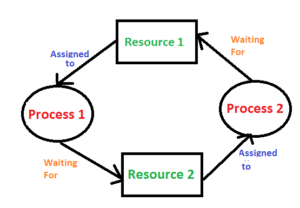
The graph is still difficult to navigate visually. They can, instead, join to your temporary holding table.Īn order of operations deadlock can be resolved or prevented, but it might take some time and heuristic troubleshooting to reach an ideal state.
DEADLOCK DATABASE UPDATE
It also speeds up the entire operation by reducing the complexity of update queries joining to tables that aren't being updated. Doing so prevents locks on objects that don't need to be locked as part of the transaction. Place any "list" information you need to use outside the scope of the transaction in a temporary table. Here is one method: When deadlocks are happening with transactions that escalate locks, isolating only the rows of data that need to be changed can help. It could be prevented by timing operations differently, tuning queries to run faster, changing the transaction isolation level, or any number of other ways. There is no definite answer to this question.
DEADLOCK DATABASE FULL
You can also view details about the other processes in the grid to get a full picture of the objects and SQL statements involved.Ī view of deadlock victim details in the SQL Sentry deadlock details grid How Can I Prevent an Order of Operations Deadlock? This helps you fully understand what failed for the victim and what it was trying to do. If SPID 63 is selected on the graph, you'd quickly see the details in grid format. Neither SPID 63 nor SPID 64 can continue, and SPID 63 was chosen as the victim. SPID 64 holds an exclusive lock on the primary key in Invoices and requires an exclusive lock on the primary key in InvoiceLines. SPID 63 also requires an exclusive lock on the primary key in Invoices. In this example, you can see that SPID 63 holds an exclusive lock on the primary key in InvoiceLines. The ability to replay the requested order of lock operations can help immensely in finding a way to prevent the deadlock. As you'll see in some of the upcoming examples, SQL Server deadlocks can become far more complicated than this one. In the screenshot to right, the replay controls are highlighted to illustrate that the screenshot was taken toward the end of the "playback" of the deadlock.
DEADLOCK DATABASE DOWNLOAD
You can download the kit to try it out for yourself. The following example comes from the Plan Explorer Demo Kit that Aaron Bertrand put together. This deadlock happens when exclusive locks are used or locks escalate between different processes that need respective resources.

It is also one of the types of deadlocks that is preventable. In the Deadlock situation, both the processes trying to access a particular resource and also has a lock on that resource by each other, so both are waiting for each other to release a lock and complete the transaction.ĭeadlock is a next stage of the blocking situation so if you want to avoid Deadlock situation, you should first find the blocked transaction and tried to remove internal dependency for those transactions.An order of operations deadlock is what most people think of when they consider deadlocks in SQL Server. One X process is waiting to complete the transaction of the Y process, and the same time, Y process is blocked because it is also waiting to complete the transaction of the X process. If the long-running blocked transaction requires a lock, it may generate a Database Deadlock. If the blocked transaction is waiting for a long time, it may generate a Database Timeout. This is called blocking because one transaction is blocked by another transaction and all blocked processes kept in the waiting queue. If two processes are accessing the same resource so at that time one process has to wait until the other process releases the occupied resource. There are different types of lock like Exclusive Lock, Non-exclusive Lock.Īn Exclusive Lock prevents object or data from the reading and writing both the actions.Ī Non-Exclusive Lock allows read-only access for an object or data, but it prevents the write action for an object or data. When one process is accessing an object, it can request for a lock for that particular object so that other processes cannot perform read or update on that object.

The Database Timeout cannot affect to other running connection, and it treated independently, but for solving the Timeout issue we need to check other causes like OS response, Network response, Database Timeout threshold value, number of Database Connections and other. There are multiple reasons for Timeout like transaction blocking, the distance network, high CPU utilization and multiple request user request at one time.

When the client application is waiting for a require resource, Timeout occurs.


 0 kommentar(er)
0 kommentar(er)
